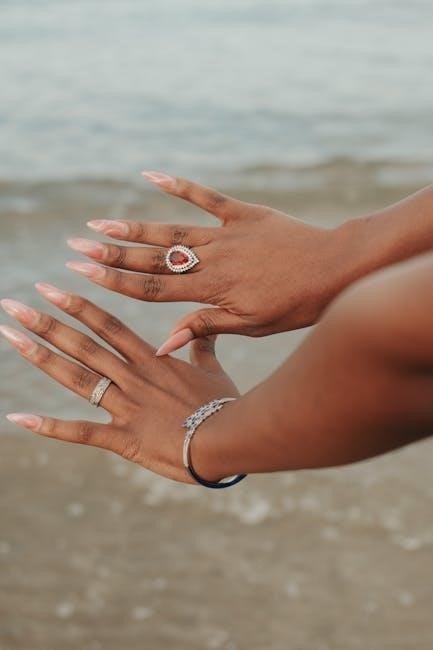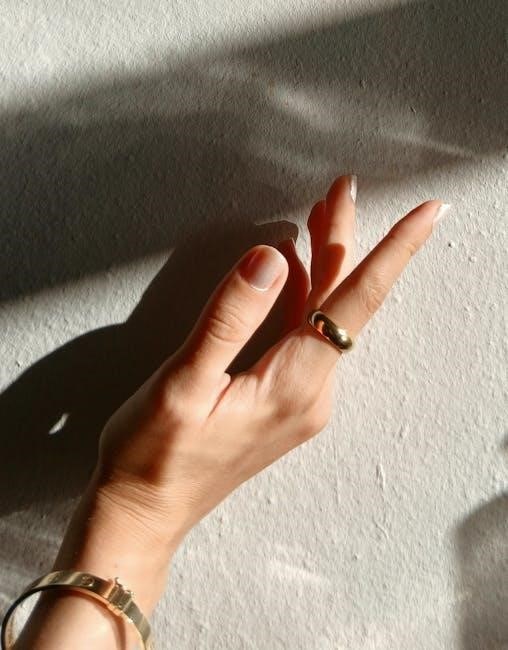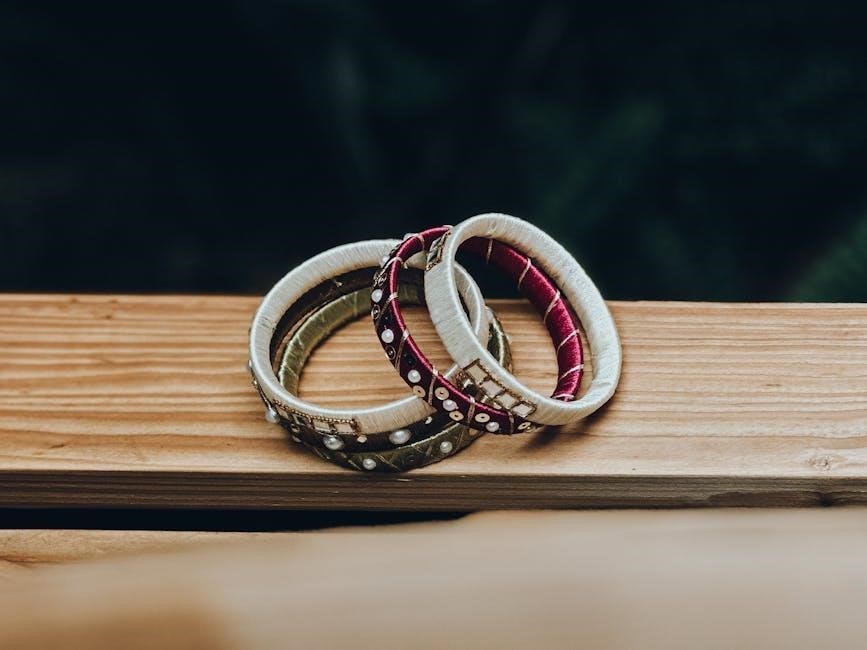Paracord bracelets are versatile, practical, and customizable accessories with a strong focus on survival utility. They combine creativity, durability, and functionality, making them popular among outdoor enthusiasts and crafters alike.
What is a Paracord Bracelet?
A paracord bracelet is a versatile accessory made from durable 550 paracord, offering both style and survival functionality. It is typically woven into intricate knots, such as the cobra braid, and can be unraveled to provide up to several meters of cord for emergencies. These bracelets are popular for their practicality, as they can be worn daily and serve as a quick source of cordage in the wilderness. Many designs are customizable, allowing users to choose colors, patterns, and even add beads or charms. Some versions omit buckles, relying solely on the paracord’s strength, while others incorporate metal or plastic buckles for added security. They are a testament to creativity and preparedness, making them a favorite among outdoor enthusiasts and crafters alike.
Popularity and Practical Uses
Paracord bracelets have gained widespread popularity due to their versatility and practicality. They are favored by outdoor enthusiasts, survivalists, and DIY crafters for their dual purpose as both a stylish accessory and a functional survival tool. Made from durable 550 paracord, these bracelets can be unraveled to provide up to 3 meters of cordage, ideal for emergencies, camping, or hiking. Their popularity stems from their ability to serve as a quick source of cordage while being worn daily. The bracelets also appeal to a wide audience due to their customizable designs, offering a blend of creativity and utility that makes them both fashionable and functional.
Why Make Your Own Paracord Bracelet?
Making your own paracord bracelet offers a unique combination of creativity, cost-effectiveness, and practicality. It allows you to customize the design to suit your style, choosing from a wide range of colors, patterns, and accessories. This DIY project is also an excellent way to develop your knot-tying and crafting skills, providing a sense of accomplishment. Additionally, crafting your own bracelet ensures durability and personalization, making it a thoughtful gift or a reliable survival tool. With minimal materials and step-by-step guides readily available, creating a paracord bracelet is an accessible and rewarding hobby for both beginners and experienced crafters.

Materials Needed
Paracord, a sturdy buckle, scissors, and a lighter are essential. Optional tools include a paracord needle for weaving. Choose plastic or metal buckles based on comfort and durability.
Paracord (Type and Length)

The most common type of paracord used for bracelets is the 550 paracord, known for its strength and durability. For a standard bracelet, you’ll need approximately 10 feet of paracord, though this can vary depending on wrist size and desired thickness. To determine the length, measure your wrist and double it, adding a little extra for knotting. For example, an 8-inch wrist requires about 8 feet of cord. Using 550 paracord ensures the bracelet is both functional and stylish, while its versatility allows for various designs and patterns. Always cut the paracord slightly longer than needed to account for knots and braiding.
Buckles (Plastic vs. Metal)
Choosing the right buckle for your paracord bracelet depends on your preference for comfort and durability. Plastic buckles are lightweight, inexpensive, and ideal for smaller wrists, while metal buckles offer strength and a sleek look. Metal buckles, though durable, can feel heavy and uncomfortable on delicate wrists. Plastic buckles are more versatile and often preferred for casual, everyday wear. Both options are widely available and easy to attach. Consider your wrist size and intended use when deciding between plastic and metal. For survival bracelets, metal buckles are more reliable, but plastic buckles are better for lightweight, practical designs.
Tools Required (Scissors, Lighter, etc.)
To make a paracord bracelet, you’ll need a few essential tools. Sharp scissors are necessary for cutting the paracord cleanly, while a lighter is used to burn and seal the ends, preventing fraying. A paracord needle can be helpful for weaving the cord through tight spaces, though it’s optional. These tools ensure a smooth and professional finish to your bracelet. Proper use of these tools is key to achieving a durable and visually appealing design. Always handle the lighter carefully to avoid accidents. With these basic tools, you can create a high-quality paracord bracelet tailored to your preferences and needs.
Optional Accessories (Paracord Needle)
An optional but handy accessory for making paracord bracelets is a paracord needle. This tool simplifies weaving the cord through tight spaces, especially when working with intricate patterns. The needle’s large eye accommodates the paracord, making it easier to thread through small loops or buckles. While not essential, it significantly speeds up the braiding process and reduces frustration. For beginners, it can help achieve cleaner, more precise knots. The paracord needle is particularly useful for complex designs like the cobra braid or fishtail patterns. It enhances the overall crafting experience, allowing for a more polished and professional finish to your bracelet.
Step-by-Step Instructions
Start by measuring your wrist and cutting the paracord to the desired length. Use a lighter to seal the ends, ensuring a clean and durable finish.
Measuring Your Wrist
Accurate wrist measurement is crucial for a comfortable and functional paracord bracelet. Use a flexible measuring tape or a piece of string to determine your wrist size. Wrap the string snugly around your wrist, mark the point where it overlaps, and measure the length with a ruler. This will give you the base length for your bracelet. Add a small allowance for the knots and buckle. For example, if your wrist measures 8 inches, you’ll typically need about 10 feet of paracord. This ensures the bracelet is neither too tight nor too loose, providing the perfect fit for everyday wear or survival situations.
Cutting the Paracord

Once you’ve determined the appropriate length based on your wrist measurement and desired bracelet size, carefully cut the paracord using sharp scissors or a utility knife. For an 8-inch wrist, approximately 10 feet of paracord is recommended. Ensure the cut is clean and avoid fraying the ends. If using a lighter, briefly pass the flame over the cut ends to seal them, preventing unraveling. This step is crucial for maintaining the integrity and appearance of your bracelet. Properly cutting and sealing the paracord sets the foundation for a durable and professional-looking finished product.
Preparing the Ends (Burning or Sealing)
After cutting the paracord to the desired length, it’s essential to seal the ends to prevent fraying. Using a lighter, carefully pass the flame over each end until the nylon melts slightly, forming a smooth, rounded tip. Be cautious not to burn yourself or overly char the paracord, as this can weaken its structure. For a cleaner finish, some crafters prefer to gently press the melted end with a tool or finger once cooled slightly. Properly sealing the ends ensures durability and a professional appearance for your bracelet. This step is critical for maintaining the integrity of the paracord and preventing unraveling during use.
Attaching the Buckle
Attaching the buckle is a straightforward process that ensures your bracelet is secure and functional. Begin by threading one end of the paracord through one side of the buckle, then tie an overhand knot to keep it in place. Repeat this step with the other end of the paracord on the opposite side of the buckle. For metal buckles, ensure the knots are tightly secured to prevent shifting. Plastic buckles may require slightly less tension but still need a firm hold. Once attached, trim any excess paracord with scissors and seal the ends with a lighter to prevent fraying. A properly attached buckle ensures durability and a comfortable fit, making the bracelet both practical and stylish.
Starting the Cobra Knot
Starting the Cobra Knot is the foundation of your paracord bracelet. Begin by holding the paracord vertically, forming a loop at the top. Cross the right strand over the left, then wrap it under and up through the loop. This creates the first half of the Cobra Knot. Repeat the process by crossing the left strand over the right, wrapping it under, and pulling it through the loop. Keep the tension even to ensure a tight, symmetrical pattern. The Cobra Knot is a popular choice for its strength and visual appeal, making it ideal for both survival bracelets and decorative wear.
Completing the Cobra Braid
To complete the Cobra Braid, continue alternating the right and left strands, ensuring each pass is tight and evenly spaced. After reaching the desired length, carefully pass the ends through the final loop to secure the braid. Gently pull both strands to tighten the knots and form a cohesive design. Use scissors to trim the excess paracord close to the buckle. For a polished finish, use a lighter to carefully burn the ends, preventing fraying and sealing the paracord. This step ensures durability and completes the bracelet, ready for wear or use in survival situations.
Tightening the Knots
Tightening the knots is crucial for ensuring the bracelet’s durability and secure fit. Once the Cobra Braid is complete, carefully pull each strand to tighten the knots evenly. Use a pair of scissors to trim the excess paracord, leaving about 1/4 inch at each end. For a polished finish, use a lighter to carefully burn the cut ends, preventing fraying and sealing the paracord. This step ensures the bracelet is not only visually appealing but also secure and practical for everyday wear or survival situations. Properly tightened knots and sealed ends guarantee the bracelet remains intact and functional over time.
Finishing the Bracelet
Once the knots are tightened, your bracelet is nearly complete. Trim the excess paracord close to the final knot using sharp scissors. To prevent fraying, carefully burn the cut ends with a lighter for a few seconds. Ensure the buckle is securely attached and the bracelet fits comfortably. Double-check the tightness of all knots and adjust if necessary. Your paracord bracelet is now ready to wear, offering both style and functionality. The finished product is durable, practical, and ready for everyday use or survival situations. Proper finishing ensures the bracelet remains secure and long-lasting, making it a reliable accessory for any occasion.

Customizing Your Bracelet
Customizing your paracord bracelet allows for personalization, enabling you to reflect your style or specific needs, whether for survival, fashion, or practical purposes.
Choosing Colors and Patterns
Choosing the right colors and patterns for your paracord bracelet is a great way to personalize it. Colors can reflect your personality, favorite team, or outdoor gear style, while patterns like the cobra knot or fishtail add visual interest. For a subtle look, stick to a single color, or mix two colors for a bold design. Consider the occasion—bright colors for casual wear or neutral tones for formal events. Patterns can also highlight the bracelet’s texture and durability. Experiment with different combinations to create a unique piece that matches your aesthetic preferences.
Adding Beads or Charms
Add a personal touch to your paracord bracelet by incorporating beads or charms. These can be placed at specific intervals, such as near the buckle or intertwined within the braid, to create a unique design. Beads can add texture, color contrast, and even functional elements like whistle beads for survival purposes. Charms, on the other hand, allow for thematic customization, such as nature-inspired shapes or symbolic emblems. When adding beads, ensure they are securely threaded onto the paracord, and consider using a paracord needle for easier handling. This step enhances both the aesthetic and practical value of your bracelet, making it truly one-of-a-kind.
Two-Color vs. Single-Color Designs
Choosing between two-color and single-color designs depends on your desired aesthetic and functionality. Two-color designs allow for creative patterns like the cobra braid, offering visual contrast and a personalized touch. This method is ideal for those who want a unique, eye-catching accessory. Single-color designs, however, provide a sleek, minimalist look and are often easier to craft for beginners. Both options offer durability and survival utility, as the paracord remains the same regardless of color choice. For a bold statement, two-color designs are recommended, while single-color options are perfect for simplicity and versatility in everyday wear or outdoor use.
Adjusting the Length
Adjusting the length of your paracord bracelet ensures a comfortable and secure fit. Measure your wrist to determine the appropriate size, typically matching the cord length to your wrist circumference. For example, an 8-inch wrist usually requires about 8 feet of paracord. During the braiding process, you can tighten or loosen knots slightly to fine-tune the fit. If needed, trim excess cord and seal the ends. This step ensures your bracelet is both functional and comfortable, whether for daily wear or outdoor adventures, while maintaining its durability and survival utility.

Survival Features of Paracord Bracelets
Paracord bracelets are designed with survival in mind, offering a reliable source of strong, versatile cordage. The 550 paracord provides exceptional strength and durability for emergencies.

Understanding the Cord Strength
The 550 paracord, commonly used in bracelets, is designed to withstand a minimum of 550 pounds of force, making it highly durable for survival and outdoor tasks. Its strength comes from its braided nylon construction, which ensures resistance to wear and tear. The cord’s versatility allows it to be used for securing gear, creating shelter, or even as a lifeline in emergencies. The tightly woven strands distribute weight evenly, preventing breakage under stress. This reliability makes it a popular choice for paracord bracelets, ensuring they can serve as both a practical accessory and a vital survival tool in challenging situations.
Unraveling the Paracord for Emergency Use
Paracord bracelets are designed to be unraveled quickly in emergencies, providing instant access to the durable cord within. The process involves carefully cutting or untying the knots to release the paracord, which can then be used for securing shelter, creating a makeshift rope, or even as a lifeline. The 550 paracord is strong enough to hold significant weight, making it reliable for survival tasks. By unraveling the bracelet, you can utilize the full length of the cord, ensuring it remains intact for critical situations. This feature underscores the practicality of paracord bracelets as essential tools for outdoor adventures and emergencies, combining fashion with functionality.
Integrated Survival Tools
Paracord bracelets often feature integrated survival tools, enhancing their utility in emergency situations. Many designs incorporate a ferrocerium rod for fire starting or a small whistle for signaling. These tools are discreetly embedded within the bracelet, ensuring they remain accessible without compromising the bracelet’s aesthetic or comfort. The paracord itself serves as a reliable source of strong cordage, while additional components like fire starters or knives provide essential survival functions. This integration makes the bracelet a comprehensive survival accessory, combining practicality with versatility. Whether for camping or unexpected emergencies, the integrated tools within a paracord bracelet can significantly improve your ability to respond effectively, making it a valuable asset for outdoor enthusiasts.
Practical Uses in the Wilderness
Paracord bracelets are indispensable in wilderness settings, offering a multitude of practical applications. The paracord can be unraveled to secure shelter, create snares, or repair equipment. Its durability ensures it can withstand harsh conditions, making it ideal for securing loads or creating makeshift tow lines. Additionally, the cord can be used for first aid, such as securing splints or creating a sling. The integrated tools, like a ferrocerium rod, enable fire starting, a critical survival skill. Whether for camping, hiking, or emergency situations, the paracord bracelet serves as a versatile and reliable resource, enhancing safety and self-sufficiency in the wild.
Tips and Tricks
Avoid common mistakes like uneven knots or loose braids. Practice tightening knots gradually and use a lighter to seal paracord ends for durability. Experiment with alternative knotting techniques to enhance your design and functionality, ensuring a snug yet comfortable fit. Properly store your bracelet to maintain its shape and integrity, and consider customization options to personalize your creation. These tips will help you master the craft and enjoy your paracord bracelet for years to come.
Common Mistakes to Avoid
When making a paracord bracelet, common mistakes include incorrect wrist measurement, uneven knotting, and insufficient tightening. Cutting the paracord too short or too long can lead to a poor fit. Avoid leaving loose ends or failing to burn the paracord tips, as this can cause fraying. Over-tightening knots may result in discomfort, while under-tightening can lead to a bracelet that falls apart. Using low-quality paracord or buckles can compromise durability. To prevent these issues, measure carefully, follow step-by-step instructions, and practice knotting techniques. Properly sealing ends with a lighter ensures a professional finish. Attention to detail will help you create a sturdy, long-lasting bracelet.
Improving Knot Quality
Enhancing knot quality is essential for a durable and visually appealing paracord bracelet. Ensure consistent tension while knotting to prevent unevenness. Use a steady hand and maintain tight loops to avoid loose strands. Regularly tighten each knot as you progress, especially in patterns like the cobra braid. To achieve uniformity, keep the same amount of slack throughout the design. If necessary, use a tool like a paracord needle to adjust knots. Properly aligning each strand ensures a polished look. Practice basic knots like the square knot and lark’s head before advancing to complex designs. Patience and attention to detail will significantly improve the overall quality of your knots and the bracelet’s appearance.
Using Alternative Knotting Techniques
Exploring alternative knotting techniques can elevate your paracord bracelet-making skills and add unique touches to your designs. Beyond the cobra knot, consider experimenting with the fishtail pattern or diamond knot for a different texture and style. These knots not only enhance the bracelet’s visual appeal but also offer functional benefits, such as easier unraveling for emergency situations. For instance, the square knot and lark’s head are versatile options that can be incorporated into various designs. Additionally, macramé techniques like the wide rainbow bracelet pattern introduce bold, colorful styles. Tutorials and PDF guides often provide step-by-step instructions for mastering these knots, allowing you to expand your creativity and create one-of-a-kind pieces. Experimenting with alternative techniques ensures your bracelets stand out while maintaining their practicality and durability.
Storing Your Paracord Bracelet
Properly storing your paracord bracelet ensures it remains in excellent condition and ready for use. Keep it in a cool, dry place, away from direct sunlight and moisture. Avoid stretching or bending the bracelet excessively, as this can weaken the knots over time. Store it separately from other accessories to prevent tangling or damage. For added protection, consider placing it in an airtight container or ziplock bag. Regularly inspect the cord and knots for wear or fraying. By following these simple storage tips, your paracord bracelet will remain durable and functional, whether for everyday wear or emergency situations.

Advanced Patterns and Designs

Explore intricate designs like macramé knots, wide rainbow patterns, and fishtail weaves. These techniques offer unique styles, blending creativity with durability for personalized paracord bracelet projects.
Macramé knots are essential for creating intricate paracord bracelet designs. These knots, such as the square knot, allow for various patterns and textures, enhancing the bracelet’s appearance and durability. By mastering macramé knots, you can craft more complex designs, including wide rainbow bracelets and fishtail patterns, which add a unique touch to your paracord projects. These techniques are versatile and can be used for other crafts, making macramé a valuable skill for any crafter. With practice, you can create stunning, personalized bracelets that showcase your creativity and skill.
Creating a Wide Rainbow Bracelet
A wide rainbow bracelet is a bold and vibrant variation of the classic paracord bracelet. This design uses multiple colors to create a striking, multi-stranded pattern that stands out. Unlike smaller bracelets, the wide version offers a more dramatic look, making it a popular choice for those who want to make a statement. To create this bracelet, you’ll need several colors of paracord, a buckle, and basic tools like scissors and a lighter. The process involves weaving the paracord strands together using macramé knots to achieve the wide, layered effect. This bracelet is not only visually appealing but also customizable, allowing you to experiment with different color combinations and patterns to suit your style.
Step-by-Step Guide to the Square Knot
The square knot, also known as the reef knot, is a fundamental knotting technique essential for creating various paracord bracelet designs. To begin, hold two strands of paracord together, crossing one over the other to form an “X” shape. Next, take the right strand and wrap it under the left, bringing it up and over to create the first loop. Repeat this process with the left strand, wrapping it under the right and bringing it up to form the second loop. Tighten the knot by pulling both strands firmly to secure it in place. This knot is versatile and forms the base for more complex patterns, making it a crucial skill for any paracord crafter to master.
Mastering the Fishtail Pattern
The fishtail pattern is a popular and visually appealing design for paracord bracelets, creating a woven, two-color aesthetic. To master this pattern, begin by cutting two strands of paracord, one for the base and one for the design. Attach both strands to a buckle, ensuring the base strand is centered. Cross the design strand over the base, then loop it under and back through the gap. Repeat this process, alternating sides, to create the fishtail effect. Pull each loop tight to secure it. This pattern works best with contrasting colors and results in a sleek, woven appearance. Practice ensures even tension and a professional finish.

Creating paracord bracelets is a rewarding DIY project that combines creativity with practicality. With patience, you can craft durable, stylish accessories perfect for gifts or personal use.
Final Thoughts on Making Paracord Bracelets
Creating a paracord bracelet is a fulfilling DIY project that combines creativity with practicality. It allows you to craft a durable, versatile accessory that serves as both a survival tool and a stylish statement. The process is rewarding, as you transform simple cord into a functional item. Whether for personal use or as a gift, paracord bracelets showcase your skill and attention to detail. They also offer a sense of preparedness, knowing you carry a reliable source of cordage. Experiment with colors, patterns, and designs to make each bracelet unique. Share your creations and inspire others to embrace this timeless craft.
Encouragement to Experiment and Share
Embrace creativity and explore the endless possibilities of paracord bracelet-making. Experiment with colors, patterns, and knots to create unique designs that reflect your personality. Sharing your creations with others not only spreads inspiration but also fosters a sense of community. Whether through social media, workshops, or gifts, your handmade bracelets can spark joy and curiosity in others. Don’t hesitate to try new techniques or adapt traditional methods to innovate. The process of making and sharing paracord bracelets is a rewarding journey that encourages learning, creativity, and connection. Keep experimenting, and inspire others to join the craft!
Importance of Practice and Patience
Crafting paracord bracelets requires patience and consistent practice to master the techniques. While step-by-step guides provide clear instructions, developing muscle memory and improving knot quality takes time. Don’t be discouraged by initial frustration—each attempt brings you closer to perfection. Patience ensures that your knots are secure and your design is visually appealing. As you progress, you’ll gain confidence in your skills and the ability to create functional, stylish accessories. Remember, practice is key to achieving professional-looking results. With persistence, you’ll unlock the full potential of paracord crafting, creating beautiful and durable bracelets that serve both as fashion statements and survival tools.
